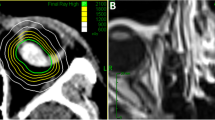Background and Purpose:
There is no evidence in the literature about the incidence of synchronous brain metastases in patients with choroidal metastases. This is of major importance, because the radiation fields of choroidal metastases and, later on, brain metastases, if treated consecutively, are partly overlapping, thus potentially increasing the rate of late side effects such as brain necrosis. The goal of this study was to determine the frequency of synchronous brain metastases.
Patients and Methods:
50 patients with choroidal metastases were enrolled into a study of the “Arbeitsgemeinschaft Radiologische Onkologie” of the German Cancer Society (ARO 95-08) with standardized 40 Gy radiotherapy, 2 Gy single dose. All patients were staged before treatment with a computed tomography of the brain (CCT). No patient showed clinical signs of brain metastases.
Results:
13 out of 50 patients (26%) had brain metastases in the CCT leading to radiotherapy of the brain and choroidal metastases in one volume.
Conclusion:
A CCT is indicated at the diagnosis of choroidal metastases for screening of synchronous brain metastases. The incidence is about 25%, and the diagnosis of brain metastases results in a different target volume: the whole brain including the posterior parts of the eyes compared to the posterior parts of the eyes alone. Therefore, the risk of late side effects could be reduced compared with an additional later radiotherapy of the whole brain with partly overlapping fields.
Hintergrund und Ziel:
Bislang gibt es in der Literatur keine Angaben zur Inzidenz synchroner Hirnmetastasen bei Patienten mit Aderhautmetastasen. Dies ist von großer Bedeutung, da die Bestrahlungsfelder von Aderhautmetastasen und ggf. späterer Hirnmetastasen sich partiell überschneiden, wodurch das Risiko von Spätfolgen der Strahlentherapie, wie fokale Hirnnekrosen, erhöht ist. Ziel dieser Arbeit war die Bestimmung der Inzidenz synchroner Hirnmetastasen.
Patienten und Methodik:
50 Patienten mit Aderhautmetastasen wurden in eine Studie der Arbeitsgemeinschaft Radiologische Onkologie der Deutschen Krebsgesellschaft (ARO 95-08) zur standardisierten Strahlentherapie mit 40 Gy, Einzeldosis 2 Gy, eingeschlossen. Bei allen Patienten wurde vor Beginn der Strahlentherapie eine kraniale Computertomographie (CCT) mit Kontrastmittel durchgeführt. Kein Patient zeigte zu diesem Zeitpunkt klinische Zeichen einer zerebralen Metastasierung.
Ergebnisse:
13 von 50 Patienten (26%) hatten im CCT Hirnmetastasen, die eine Ganzhirnbestrahlung inkl. der Aderhautmetastasen in einem Volumen zur Folge hatte.
Schlussfolgerung:
Eine CCT ist zum Zeitpunkt der Diagnose von Aderhautmetastasen zum Screening synchroner Hirnmetastasen indiziert. Die Inzidenz liegt bei etwa 25%. Die Diagnose zerebraler Metastasen führt zu einem anderen Bestrahlungsvolumen: das gesamte Neurokranium inkl. der hinteren Augenabschnitte verglichen mit den hinteren Augenabschnitten allein. Somit kann das Risiko von Spätkomplikationen im Vergleich zu einer zusätzlichen späteren Ganzhirnbestrahlung mit partieller Feldüberschneidung reduziert werden.
Similar content being viewed by others
Author information
Authors and Affiliations
Corresponding author
Rights and permissions
About this article
Cite this article
Bottke, D., Wiegel, T., Kreusel, KM. et al. Is a Diagnostic CT of the Brain Indicated in Patients with Choroidal Metastases Before Radiotherapy?. Strahlenther Onkol 181, 251–254 (2005). https://doi.org/10.1007/s00066-005-1336-4
Received:
Accepted:
Issue Date:
DOI: https://doi.org/10.1007/s00066-005-1336-4




